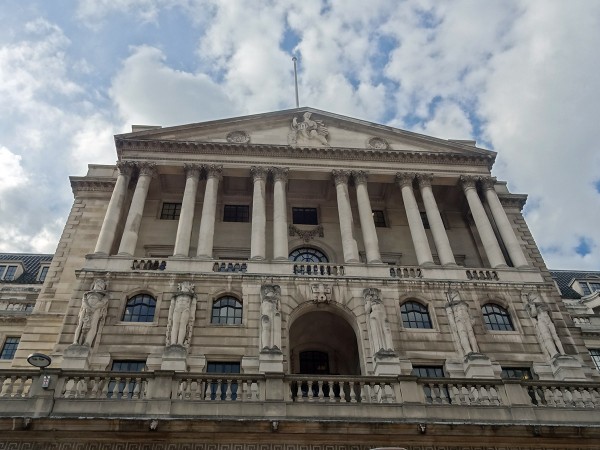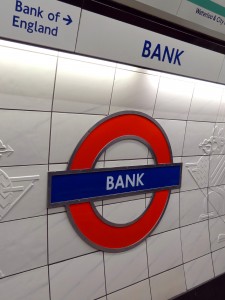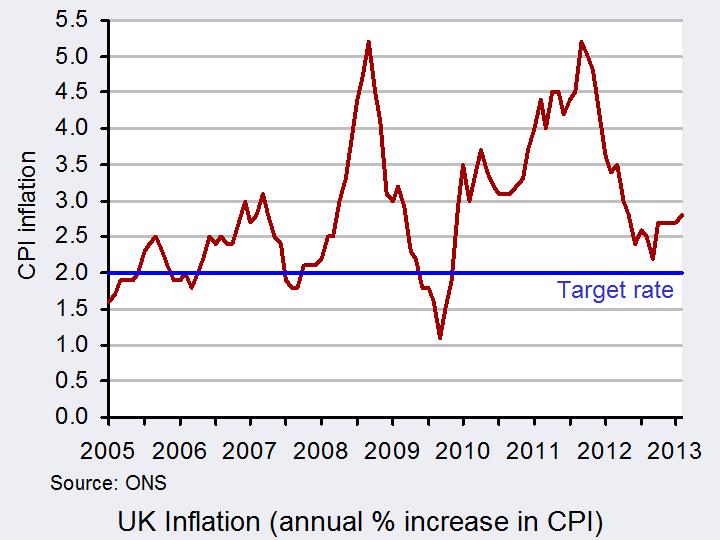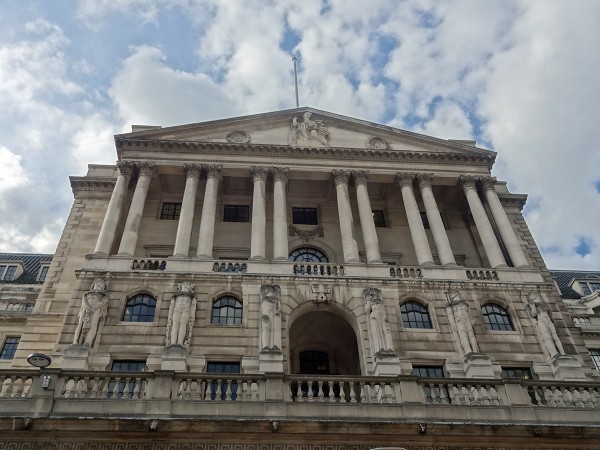 With the publication of the February 2014 Inflation Report the Bank of England has adjusted its forward guidance to the markets.
With the publication of the February 2014 Inflation Report the Bank of England has adjusted its forward guidance to the markets.
As we saw in Part 1 of this blog, the economy should soon fall below the 7% unemployment threshold adopted in the original forward guidance issued last August. But the Bank feels that there is still too much slack in the economy to raise interest rates when unemployment does fall below 7%.
The Bank has thus issued a new vaguer form of forward guidance.
The MPC’s view is that the economy currently has spare capacity equivalent to about 1%–1½% of GDP, concentrated in the labour market. Around half of that slack reflects the difference between the current unemployment rate of 7.1% and an estimate of its
medium-term equilibrium rate of 6%–6½%. The remaining slack largely reflects a judgement that employees would like to work more hours than is currently the case. Companies appear to be operating at close to normal levels of capacity, although this is subject to some uncertainty.
The existence of spare capacity in the economy is both wasteful and increases the risk that inflation will undershoot the target in the medium term. Moreover, recent developments in inflation mean that the near-term trade-off between keeping inflation close to the target and supporting output and employment is more favourable than at the time the MPC announced its guidance last August: CPI inflation has fallen back to the 2% target more quickly than anticipated and, with domestic costs well contained, is expected to remain at, or a little below, the target for the next few years. The MPC therefore judges that there remains scope to absorb spare capacity further before raising Bank Rate.
Just what will determine the timing and pace of tightening? The Bank identifies three factors: the sustainability of the recovery; the extent to which supply responds to demand; and the evolution of cost and price pressures. But there is considerable uncertainty about all of these.
Thus although this updated forward guidance suggests that interest rates will not be raised for some time to come, even when unemployment falls below 7%, it is not at all clear when a rise in Bank Rate is likely to be, and then how quickly and by how much Bank Rate will be raised over subsequent months. Partly this is because of the inevitable uncertainty about future developments in the economy, but partly this is because it is not clear just how the MPC will interpret developments.
So is this new vaguer forward guidance helpful? The following articles address this question.
Articles
Bank of England Governor Carney’s statement on forward guidance Reuters (12/2/14)
Why has Mark Carney tweaked forward guidance? The Telegraph, Denise Roland (12/2/14)
Interest rates: Carney rips up ‘forward guidance’ policy Channel 4 News (12/2/14)
Forward guidance version 2: will the public believe it? The Guardian, Larry Elliott (12/2/14)
Mark Carney adjusts Bank interest rate policy BBC News (12/2/14)
Mark Carney’s almost promise on rates BBC News, Robert Peston (12/2/14)
Did the Bank of England’s Forward Guidance work? Independent, Ben Chu (2/2/14)
Forward Guidance 2.0: Is Carney just digging with a larger shovel? Market Watch, The Tell (12/2/14)
The U.K. Economy: Five Key Takeaways Wall Street Journal, Alen Mattich (12/2/14)
Bank of England pages
Inflation Report, February 2014 Bank of England (12/2/14)
Monetary Policy Bank of England
MPC Remit Letters Bank of England
Forward Guidance Bank of England
Questions
- Summarize the new forward guidance given by the Bank of England.
- Why is credibility an important requirement for policy?
- What data would you need to have in order to identify the degree of economic slack in the economy?
- Why is it difficult to obtain such data – at least in a reliable form?
- What is meant by the ‘output gap’? Would it be a good idea to target the output gap?
- Is it possible to target the rate of inflation and one or more other indicators at the same time? Explain.
 The Bank of England was granted independence to set interest rates back in 1997. This is known as instrument independence. However, the remit is set by the government and so it does not have goal independence. Amongst the policy announcements on Budget day (Wed 20 March), the government detailed amendments to the Bank’s remit. In particular, the remit now more explicitly acknowledges that, in exceptional circumstances, the Bank might need to pay more attention to output variability.
The Bank of England was granted independence to set interest rates back in 1997. This is known as instrument independence. However, the remit is set by the government and so it does not have goal independence. Amongst the policy announcements on Budget day (Wed 20 March), the government detailed amendments to the Bank’s remit. In particular, the remit now more explicitly acknowledges that, in exceptional circumstances, the Bank might need to pay more attention to output variability.
Despite the amendments to its remit, the Bank of England continues to have a forward-looking operational inflation rate target of 2 per cent (with a range of tolerance of up to 1 percentage point). The MPC therefore sets the Bank Rate, i.e. the rate at which it engages in short-term lending to financial institutions, to affect general interest rates in the economy. In turn, the level of interest rates is assumed to affect the level of aggregate demand and, hence, the rate of demand-pull inflation as well as inflation rate expectations.
A key economic benefit of delegating interest rate decisions to the Monetary Policy Committee (MPC) is thought to be lower inflation rate expectations. By granting the Bank of England operational or instrument independence, inflation announcements have a credibility that they would not if monetary policy was under the control of elected politicians. So why change the inflation rate remit?
 The government remains of the view that inflation rate targeting has served the UK well, despite inflation being persistently above target for the past three years (see chart: click here for a PowerPoint). However, it has sought to clarify how the Bank of England might be expected to behave in exceptional circumstances when the economy is buffeted by shocks and disturbances, such as those that it has faced following the financial crisis of the late 2000s. The government argues that in such circumstances the output volatility that could result by ensuring that inflation remains on target could be undesirable. Therefore, the MPC should give consideration to the volatility of output that targeting inflation would cause in such exceptional circumstances.
The government remains of the view that inflation rate targeting has served the UK well, despite inflation being persistently above target for the past three years (see chart: click here for a PowerPoint). However, it has sought to clarify how the Bank of England might be expected to behave in exceptional circumstances when the economy is buffeted by shocks and disturbances, such as those that it has faced following the financial crisis of the late 2000s. The government argues that in such circumstances the output volatility that could result by ensuring that inflation remains on target could be undesirable. Therefore, the MPC should give consideration to the volatility of output that targeting inflation would cause in such exceptional circumstances.
The amended remit says that in setting monetary policy the MPC should communicate to the public the trade-offs that are inherent in meeting its forward-looking inflation rate target. Therefore, during exceptional times, the Bank may communicate that the volatility of output resulting from returning inflation to target would be so large that it is prepared to keep monetary policy looser than it otherwise would. This could mean indicating a time-frame over which it would be expected to keep interest rates lower than otherwise. By communicating this, it would in effect be looking to affect peoples’ expectations and, importantly, their behaviour. The prospect of prolonged low interest rates, such as those currently being experienced, might encourage greater expenditure, especially as a result of lower borrowing costs – though of course this is not guaranteed!
 The Governor will continue to write an open letter to the Chancellor of the Exchequer if inflation moves away from the target by more than 1 percentage point in either direction. However, in a change to the previous remit, this will be done in conjunction with the minutes of the MPC meeting that follow the publication of the official inflation figures by the Office for National Statistics. By publishing the letter alongside the minutes, it gives the MPC more time to consider its strategy and to give due consideration to the trade-offs in returning inflation to the target. If inflation remains more than 1 percentage point above or below the target the Governor will need to write a further letter after three months. This letter would be alongside the minutes of the third subsequent meeting of the MPC.
The Governor will continue to write an open letter to the Chancellor of the Exchequer if inflation moves away from the target by more than 1 percentage point in either direction. However, in a change to the previous remit, this will be done in conjunction with the minutes of the MPC meeting that follow the publication of the official inflation figures by the Office for National Statistics. By publishing the letter alongside the minutes, it gives the MPC more time to consider its strategy and to give due consideration to the trade-offs in returning inflation to the target. If inflation remains more than 1 percentage point above or below the target the Governor will need to write a further letter after three months. This letter would be alongside the minutes of the third subsequent meeting of the MPC.
Some commentators argue that the amended remit is merely a reflection of the current reality. In other words, the remit is being rewritten in a way which reflects how the MPC is currently making its interest rate decisions. Others are concerned that what was a simple and clear objective is now not the case and that this may have implications for the credibility of monetary policy. Whatever the rights and wrongs, Wednesday’s announcement was an important development in the history of central bank independence in the UK.
Documents
Remit for the Monetary Policy Committee Bank of England, March 2013
Governor Response to the remit for the Monetary Policy Committee Bank of England , March 2013
Articles
Bank of England handed new remit in Osbourne’s budget Guardian, Josephine Moulds (20/3/13)
Budget: Changing the Bank of England Remit Sky News, Ed Conway (20/3/13)
Budget 2013: Bank of England’s monetary policy remit changed Telegraph, Angela Monaghan (20/3/13)
King warns against ‘major change’ to Bank’s remit ITV News (15/3/13)
Chancellor adjusts Bank of England inflation remit Financial Times, Nick Reeve (20/3/13)
Budget 2013: Bank of England gets new orders BBC News (20/3/13)
Questions
- Why would monetary policy be expected to be more credible under an independent central bank?
- How might a lack of credibility over monetary policy affect the economy’s rate of inflation?
- Outline the advantages and disadvantages of the changes to the Bank of England’s remit.
- Central bank independence constrains discretion over monetary policy. Should governments constrain their discretion over fiscal policy? What are the advantages and disadvantages?
- Explain how the MPC tries to affect the rate of inflation through changes in the Bank Rate?
Bank rate in the UK has been at the historically low level of 0.5% since March 2009 and the MPC decision on 13 January was to leave the rate unchanged (see also). But inflation has been well above the Bank of England’s target of 2% since December 2009 and it could well rise further as international commodity prices are soaring. Some economists are thus arguing that Bank rate should rise. This is crucial, they say, to dampen inflationary expectations.
Other economists, however, argue that aggregate demand is likely to remain depressed and that the economy is operating with a large negative output gap. What is more, house prices are falling, as are real wages (see Bosses gain – workers’ pain)
In the following extract from BBC Radio 4’s Today Programme, two economists, Charles Goodhart and Willem Buiter, both former members of the MPC, debate the issue.
Podcast
 Should interest rates rise? BBC Today Programme (13/1/11)
Should interest rates rise? BBC Today Programme (13/1/11)
Data
Economic and Labour Market Review, Office for National Statistics (For inflation data see Tables Chapter 3, Table 3.01; for interest rates see Tables Chapter 5, Table 5.08)
Monetary Policy Committee Decisions Bank of England
Questions
- What are the arguments for a rise in Bank rate at the current time?
- What are the arguments against a rise in Bank rate at the current time?
- What information would you require to decide which of the arguments was the more powerful?
- Why is it difficult to decide the size of the output gap?
- To what extent do the arguments for and against a rise in Bank rate depend on the factors determining expectations, and what expectations are important here?
- To what extent are exchange rates relevant to the effectiveness of interest rate policy?
After the November 2009 meeting of the Monetary Policy Committee, the Bank of England announced that it would keep Bank Rate on hold at 0.5%, at which rate it has been since March. It also said that it would spend a further £25 billion over the next three months on asset purchases, primarily government bonds, thereby pumping additional money into the economy: the process known as “quantitative easing“. This would bring total asset purchases under the scheme to £200bn.
But although this represents a further increase in money supply, the rate of increase is slowing down. In the previous three months, £50 billion of assets had been purchased. So does this imply that the Bank of England sees a recovery around the corner? Will money supply have been expanded enough to finance the desired increase in spending – on both consumption and investment?
A problem so far is that most of the extra money has not been spent on goods and services. Banks have been building up their reserves, with much of the money simply being re-deposited in the Bank of England as reserve balances (see Table A1.1.1 in “Bankstats). At the same time, households have been taking on very little extra debt – indeed, In July, total household debt actually fell (see “Payback time) and consumer debt (i.e. excluding mortgages) has continued to fall. If quantitative easing is to work, the money must be spent!
But with the monetary base having expanded so much, is there a danger that, once the recovery gathers pace, spending growth will return with a vengeance? Will inflation rapidly become a problem again with an overheating economy? The following articles examine the issues.
Interest rates held at 0.5 per cent (includes video) Channel 4 News (5/11/09)
Bank of England extends quantitative easing to £200bn Guardian, Larry Elliott (5/11/09)
What the economists say: Quantitative easing £25bn boost Guardian (5/11/09)
Bank of England faced with its biggest split on policy in a decade Independent, Sean O’Grady (4/11/09)
Bank of England expands money-printing programme to £200bn to fight downturn (includes video) Telegraph (5/11/09)
The one thing worse than quantitative easing would be no QE at all Telegraph, Edmund Conway (5/11/09)
BoE: It ain’t over till it’s over Telegraph, Edmund Conway blog (5/11/09)
Bank raises stimulus to £200bn to end recession Times Online, Grainne Gilmore (5/11/09)
Bank of England to inject another £25bn of stimulus money Management Today (5/11/09)
Extra £25bn to stimulate economy BBC News (5/11/09)
Quantitative easing ‘not working’ (video of DeAnne Julius: former MPC member) BBC News (5/11/09)
Boxed in BBC Stephanomics (5/11/09)
The BoE’s £25bn gambit Financial Times, Chris Giles blog (5/11/09)
US to reduce Quantitative Easing as rates kept low Telegraph, James Quinn (4/11/09)
 Quantitative easing ‘unpleasant’ BBC Today Programme, Stephen Bell and Wilem Buiter (7/11/09)
Quantitative easing ‘unpleasant’ BBC Today Programme, Stephen Bell and Wilem Buiter (7/11/09)
Experts debate whether quantitative easing is working (video) BBC Newsnight (6/11/09)
Questions
- What has been happening to the velocity of circulation of (narrow) money in the past few months? Explain the significance of this.
- What is likely to happen to the velocity of circulation in the coming months if (a) the economy recovers quite strongly; (b) recovery is modest?
- What is the relationship between quantitative easing and the growth in broad money (i.e. M4 in the UK)? How will banks’ desire to build up their reserves affect this relationship?
- Is the UK economy in a liquidity trap? Explain.
- Why is it likely that the Bank of England may well engage in more quantitative easing next March and beyond? How is the fiscal situation likely to affect Bank of England decisions?
- Examine the argument for the Bank of England buying more private-sector debt (virtually all of the asset purchases have been of public-sector debt)?
CPI inflation in the 12 months to September 2009 fell to 1.1% (from 1.6% in the 12 months to August). RPI inflation for the same period was -1.3%. In other words, retail prices actually fell by 1.3% in the 12 months to September. According to the ONS, “By far the largest downward pressure affecting the change in the CPI annual rate came from housing and household services. This was principally due to average gas and electricity bills, which were unchanged between August and September this year but rose a year ago when some of the major suppliers increased their tariffs.” (See below for link.)
If the CPI inflation rate falls below 1% (or rises above 3%), the Governor of the Bank of England is required to write a letter to the Chancellor of the Exchequer explaining why and also what the Bank of England intends to do about this. The Bank of England targets the forecast CPI inflation 24 months’ hence and attempts to achieve a rate of 2%. Normally, if the forecast rate is below 2%, the Monetary Policy Committee will decide to cut the rate of interest. The last Bank of England Inflation Report (August 2009) forecast CPI inflation of around 1.5% in 24 months’ time. If the November Inflation Report forecasts a similar figure, or even below, what can be done? Bank Rate is already at a historic low of just 0.5% and a further cut is unlikely to have much effect. Should the Bank of England, then, engage in another dose of quantitative easing? Perhaps the letter, if it has soon to be written, will make it clear.
UK consumer price inflation at 5-year low BusinessWeek (13/10/09)
Recession helps push inflation to five-year low Independent (14/10/09)
Inflation falls to lowest in five years Guardian (13/10/09)
Inflation dip likely to be short-lived Guardian (13/10/09)
Deflation, not inflation would be the bigger threat if the Conservatives do what they say Jeremy Warner blog, Telegraph (13/10/09)
Pound hit by falling UK inflation BBC News (13/10/09)
Pound hit by falling UK inflation (video) BBC News (13/10/09)
Pound pays price as inflation slides to five-year low Times Online (14/10/09)
Investors weigh risks of inflation and deflation Financial Times (12/10/09)
 Wage ‘catch up’ for public sector BBC Today Programme (14/10/09)
Wage ‘catch up’ for public sector BBC Today Programme (14/10/09)
Current data on UK Inflation (National Statistics)
Time series data (annual, quarterly and monthly) on UK prices and inflation Economic and labour Market Review (National Statistics)
Questions
- Why did the annual rate of CPI inflation fall so much in September 2009?
- Is the Bank of England Governor likely to have to write a letter (or letters) to the Chancellor in the coming months? Explain why or why not. What is likely to be the role of expectations in determining whether a letter has to be written?
- Why did the sterling exchange rate fall on the announcement of the inflation figure? What are likely to be the effects of this? What will determine the size of these effects?
- Why may additional amounts of quantitative easing be necessary in the coming months? How would a contractionary fiscal policy affect the desirability of additional quantitative easing?
 With the publication of the February 2014 Inflation Report the Bank of England has adjusted its forward guidance to the markets.
With the publication of the February 2014 Inflation Report the Bank of England has adjusted its forward guidance to the markets.


